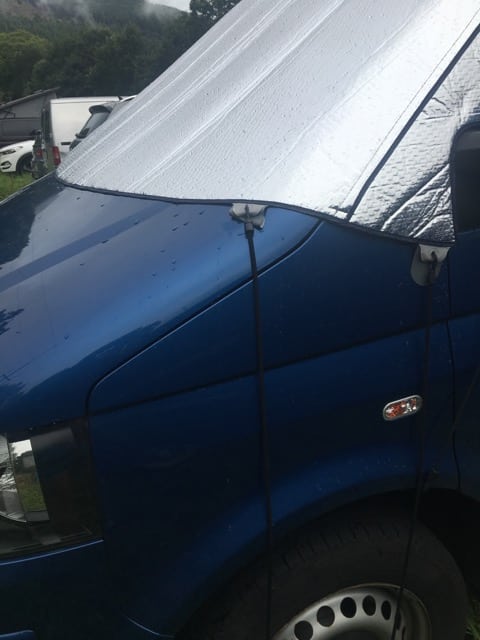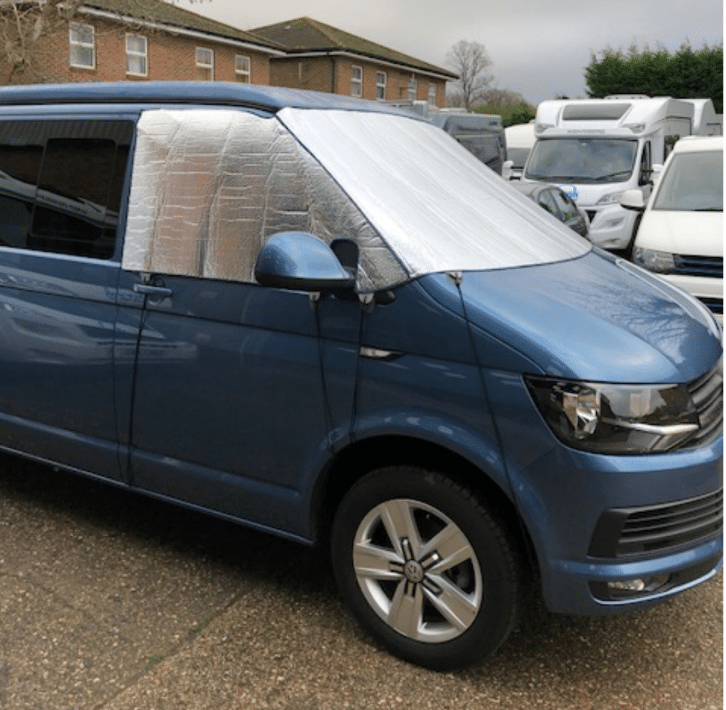I have been testing the Hindermann VW T5/T6 External Thermal Screens on my T5 campervan. Until now, I have used the internal window screens. They attach with suckers (many of which I have lost!) and I was interested to see how the external screens work.
The screens are thermal and designed to fit over the outside of the front and side windows of a campervan or motorhome. (You can buy different sizes to suit).
In winter, the screens insulate the windows against cold, while in the summer they are an effective way to keep out the sun and reduce interior heat.

The main problem for us in Britain in a campervan is condensation, especially if it is cold outside and there are two people sleeping inside. So thermal screens, either inside or outside, help to reduce condensation by providing a protective layer of insulation.
The screens are made of a “weatherproof thermal film” with “double-sided aluminium-vaporised polyester film, which has been UV-stabilised”. Basically they are pretty durable looking, have good thermal qualities and should not wear out due to UV degradation.
On test: Hindermann VW External Thermal Screens
Fitting the screens is relatively straightforward. The screen forms one large piece that you lay over the top of the front and side windows.
First you open the driver and passenger doors and slot the outer corners of the screens over the corners of the doors. This makes them stay put. There are corner pockets built into the screen so you can easily do this.

Bungees keep the screen taut.
The screen tucks around the wing mirrors and then, after that, you simply use bungees, of two different lengths, to attach to the lower edge of the screens and are then affixed to lower car rims and wheel arches.
After the first use I have left the bungees attached to the screen. This makes it very quick and easy to put on the screen. It is much, much quicker than affixing the internal screens that I own and far simpler.
It looks like it will be a big job because the screen is quite large and seems cumbersome but it is actually very simple.
If you leave off the bungees at the side doors, you can also open the doors while the screen is in place. I decided not to do this though because when I have used the screens it has been windy outside and I have been keen to make sure they fitted neatly and tightly.

The look from the inside.
If you are staying put for a while at a campsite and you don’t want to remove the screen during the day, you can flap down the front screen outside so you can see out. This is a handy feature.
The screens do work well to reduce condensation and to keep the campervan warmer at night in the winter. The form a good cover over the windows.
In my experience, there is no product that will eliminate condensation on a very cold night but these screens do reduce it significantly.

You can fit the screens so that the doors can be opened.
However, there are a couple of negatives. When it is windy the screens flap about a bit and this can be annoying if you are not a good sleeper. I wear ear plugs so I don’t hear a thing but G said he heard them flapping.
When it has been raining overnight, you need to remove wet screens and then store them somewhere. You can shake off a lot of the wet but not all of it. I haven’t found this much of a problem because the screens are stored in the van in a place where a bit of wet is okay.
You could wipe down the screens with a towel before removing and stowing them.
I have found the to be an excellent alternative to the interior version. The external screens are easier to use and it also mean the inside of the campervan is less cluttered. I have now removed the internal screens from my campervan and now only use on the external screens.
They are priced £80 at www.thecampercoshop.com.

